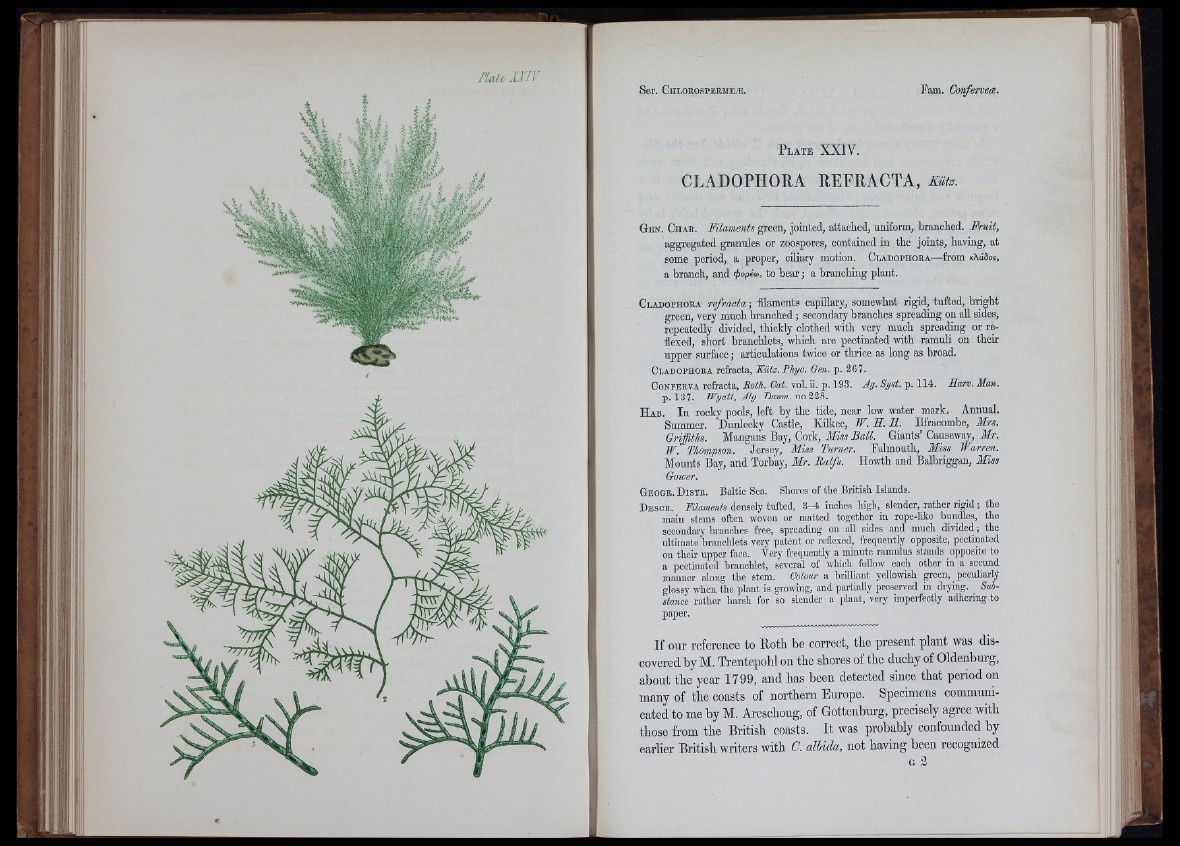
i l i '
P la t e XXIV.
CLADOPHORA REFRACTA, fife.
Gen . C h a e . Filaments green, jointed, attached, uniform, branched. Fruit,
aggregated granules or zoospores, contained in th e joints, having, at
some period, a proper, ciliary motion. C la d o p h o r a— from icXd&s,
a branch, and rpopéa, to bear ; a branching plant.
C la d o p h o r a refracta ; fflaments capillary, somewhat rigid, tufted, bright
green, very much branched ; secondary branches spreading on ah sides,
repeatedly divided, thickly clothed with very much spread.ing or reflexed,
short branohlets, which are pectinated Avith ramuli on their
upper surface; articulations twice or thrice as long as broad.
C la d o ph o r a refracta, Kiitz. Phyc. Gen. p. 267.
C o n f e r v a refracta, Roth. Gat. vol. ii. p. 193. Ag. Syst. p. 114. Harv. Man.
p. 137. Wyatt, Alg. Banm. no 228.
Hab. In rooky pools, left by the tide, near low water mark. Annual.
Summer. Dunleoky Castle, Kilkee, W. H. H. Ilfracombe, Mrs.
Griffiths. Mangans Bay, Cork, M'iss B all. Giants’ Causeway, Mr.
W. Thompson. Jersey, Miss Turner. Falmouth, Miss Warren.
Mounts Bay, and Torbay, Mr. Ralfs. Howth and Balbriggan, Miss
G e o o r . D i s t r . Baltic Sea. Shores of the British Islands.
D e s c r . Filaments densely tufted, 8-4 inches high, slender, rather rig id ; the
main stems often woven or matted together in rope-like bundles, tbe
secondary branches free, spreading on all sides and much divided; tbe
ultimate‘branchlets very patent or reflexed, frequently opposite, pectinated
on their upper face. Yery frequently a minute ramulus stands opposite to
a pectinated branchlet, several of which follow each other in a secund
manner along the stem. Colour a brilliant yeUowisb green, peculiarly
glossy when the plant is growing, and partiaUy preserved in drying. Substance
rather harsh for so slender a plant, very imperfectly adhering to
paper.
If our refereuce to Roth he correct, the preseut plaut was discovered
by M. Treutepohl ou the shores of the duchy of Oldeuburg,
about the year 1799, aud has beeu detected siuce that period ou
mauy of the coasts of northeru Europe. Specimens communicated
to me by M. Areschoug, of Gottenburg, precisely agree with
those from the British coasts. It was probably confounded by
earlier British writers with C. albida, not having been recognized
i r